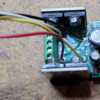Recently, there have been a few discussions about running A-A configurations with two powered units and four motors with the Cruise Commander. It is alleged by no less than the man that designed the Cruise Commander, Jon Z., that the major issue that might compromise this issue is overheating of the bridge rectifier. Apparently, this degrades the rectifier and increases the leakage currents through it enough that it compromises the FET drivers and subsequently kills them. Obviously, we want to prevent this!
I also note that the MTH boards actually heatsink the rectifier and not the driver FET's, that seems to make a lot of sense based on this information. Also, a number of larger Lionel locomotives have a DCDS that also has a tethered bridge that is bolted to the frame for heatsinking. It would have been nice if the Cruise Commander had mounted the bridge under the PCB and secured it to the heatsink as well, but we can't have everything.
Given this large body of evidence about keeping the bridge cool, I decided to modify the Cruise Commander that I'm installing in an A-A configuration with both units powered to give it a tethered bridge.
The hardest part of the job was getting the bridge off the board without damaging the board. The bridge actually manages to dissipate quite a bit of heat from the leads, apparently by design. Given that the Rectron BR84 8A bridge is only 99 cents, I decided that it wasn't worth trying to save the old bridge rectifier for the piddling amount of money it costs for a new one. I ended up removing the driver FET heatsink and folding the driver FET's out flat. Then using the Dremel tool I chopped up the bridge to remove it so I didn't damage the PCB. It was then easy to remove the remaining leads and solder my jumpers from the replacement bridge to the PCB to complete the job.
The bridge will be bolted to the chassis with heatsink compound and a flat washer on top to maximize heat transfer.






